
Elasmucha grisea, common name parent bug, is a species of shield bugs or stink bugs belonging to the family Acanthosomatidae. The term parent bugs includes also the other species of the genus Elasmucha and some species of the family Acanthosomatidae.

Dolycoris baccarum, the sloe bug or hairy shieldbug, is a species of shield bug in the family Pentatomidae.

Carpocoris mediterraneus, the red shield bug, is a species of shield bug in the family Pentatomidae.
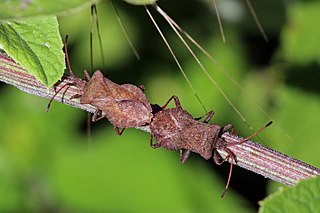
Coreus marginatus is a herbivorous species of true bug in the family Coreidae. It is commonly known as the dock bug as it feeds on the leaves and seeds of docks and sorrels. It is a medium-sized speckled brown insect, between 13 and 15 mm long as an adult, with a broad abdomen. It occurs throughout Europe, Asia and northern Africa. It is often found in dense vegetation, such as hedgerows and wasteland.
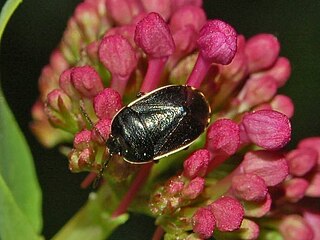
Canthophorus dubius is a species of burrowing bug belonging to the family Cydnidae, subfamily Sehirinae.
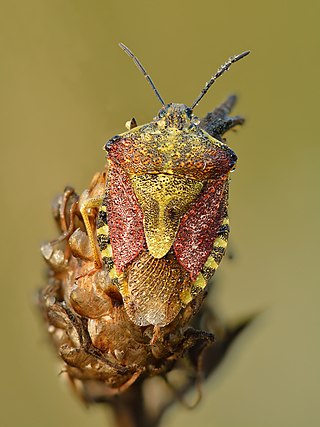
Carpocoris purpureipennis is a species of shield bug of the family Pentatomidae, subfamily Pentatominae.

Stagonomus venustissimus, common name woundwort shieldbug, is a species of shieldbug belonging to the family Pentatomidae, subfamily Pentatominae.
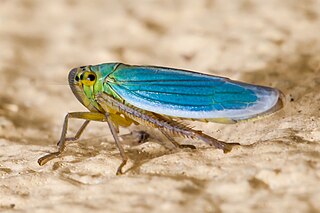
Cicadella viridis, the green leafhopper, is a species belonging to the subfamily Cicadellinae of the family Cicadellidae.

Carpocoris pudicus is a species of shield bug in the family Pentatomidae.
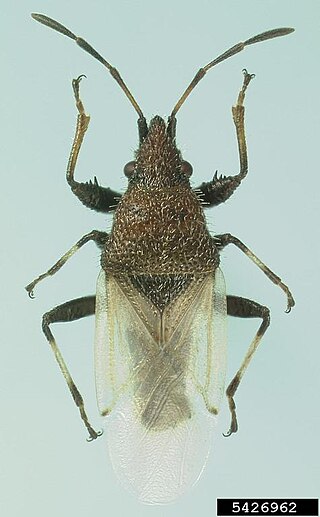
Oxycarenus hyalinipennis, common name cotton seed bug, is a species of plant bug belonging to the family Lygaeidae, subfamily Oxycareninae.
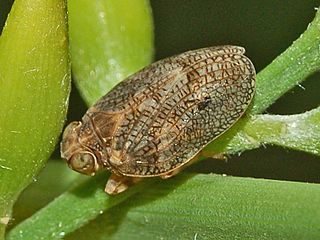
Issus coleoptratus is a species of planthopper belonging to the family Issidae.

Carpocoris fuscispinus is a species of shield bug in the family Pentatomidae.

Cosmopepla lintneriana, the twice-stabbed stink bug, is a species of insect in the family Pentatomidae. Cosmopepla lintneriana was first described in 1798 by Johan Christian Fabricius as Cimex carnifex, and then again in 1865 by Thomas Say as Cosmopepla bimaculata. Cosmopepla lintneriana is hosted by a variety of plants, including milk thistle, echinacea, asparagus, oats, mint and goldenrod, and is widespread throughout North America, from Canada to Mexico. Adult C. lintneriana are black with a red, orange, or yellow band across the pronotum and a short red stripe along the midline, and two red spots at the apex of the scutellum. Nymph coloration ranges from red to white with black markings that change as they grow.

Cermatulus nasalis is a species of predatory shield bug in the family Pentatomidae. It is commonly known as the brown soldier bug or glossy shield bug and is native to Australia and New Zealand.

Piezodorus lituratus, the gorse shield bug, is a species of Pentatomidae, a family of shield bugs.

Peribalus strictus, common name Vernal Shieldbug, is a species of shield bugs in the family Pentatomidae.
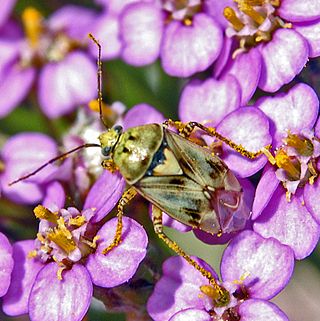
Lygus gemellatus is a species of plant-feeding insects in the family Miridae.
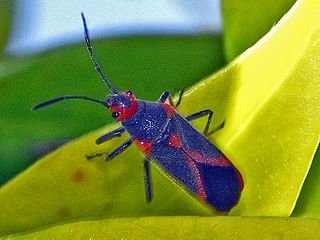
Caenocoris nerii, common name oleander seedbug, is a species of ground bugs in the insect family Lygaeidae.

Monteithiella humeralis, commonly known as the pittosporum shield bug is a species of herbivorous shield bug native to Australia and introduced in New Zealand. As its common name suggests, it is most commonly observed feeding on Pittosporum plants.

Acanthaspis quinquespinosa is a species of assassin bug found in India, Sri Lanka, Myanmar, Nepal and Tibet. It is a predator, and both nymphs and adults feed on termites, beetles, caterpillars and other insect prey.






















